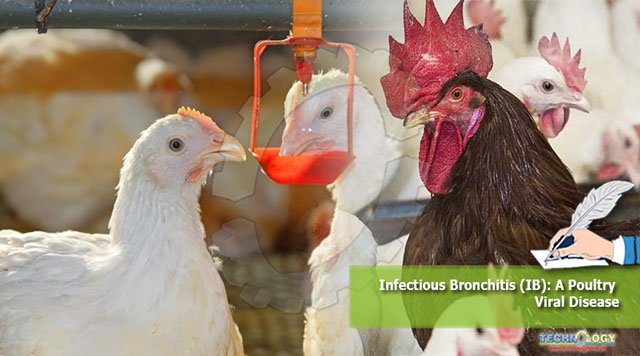Infectious bronchitis (IB) is a highly contagious upper respiratory tract as well as urogenital tract infection of chicken caused by gamma coronavirus that only produces disease in chicken.

By: Dr. Maria Jamil, Dr. Aisha Khatoon, Dr. Kashif Saleemi, Dr. Naima Waheed
Infectious bronchitis virus IBV may produce subclinical infection in peafowl and pheasant but clinically produce disease only in chicken. The IB virus many antigenic types that differ from each other and worldwide in distribution. Infected birds shed the IB virus in feces, respiratory discharge, and also transmitted through aerosol by ingesting the polluted feed and water and by contact with contaminated clothes and types of equipment. Chickens that are infected naturally, as well as vaccinated, both shed the virus sporadically for up to 20 weeks post-infection. Morbidity caused by IB virus is usually 100%, and mortality ranges from 5-60%.
The severity of infection and body system influenced by:
- Cold stress
- Strains of virus
- Age, immune status and diet of chicken
- A secondary bacterial infection such as mycoplasma gallisepticum, mycoplasma synoviae, and Escherichia coli can aggravate the infection.
Sign and symptom of infectious bronchitis in poultry:
- Initial respiratory signs such as (tracheal rales, sneezing, dyspnea, and coughing)
- Conjunctivitis and facial swelling
- Chicks become dull, depressed and huddle together near to the lamp
- Decreased weight gain and feed conversion ratio
- Wet dropping, ruffled feather and increase water intake
- IB virus causes 70%drop in egg production, and returns to normal production take about 8 weeks.
- Both internal and external quality of egg become infected (thin, wrinkle, rough and soft shell egg and watery albumin)
- IB virus also causes false layer syndrome by damaging to the oviduct
- Nephropathogenic strains produce the interstitial nephritis
Lesions of infectious bronchitis in poultry:
- Serous or caseous exudates present on nasal passages, sinuses, and trachea
- Air sacs become thicken and cloudy
- IB virus in chicks may cause the cystic ovaries
- Kidney become pale, swollen and urates deposits due to the Nephropathogenic strains
- Urolithiasis and atrophied kidney
Diagnosis of infectious Bronchitis (IB):
- Haemagglutination inhibition test (HA-HI)
- ELISA (enzyme-linked immunosorbent assay)
- Isolation of virus by taking tracheal swab, kidney tissue and cecal tonsils and inoculated to 9-11 day old chicken embryo.
- Reverse transcriptase PCR to detect the viral RNA
- For the recognition of genetic type of virus which is associated with virus serotype used the spike glycoprotein of S1 region.
Prevention and control of Infectious Bronchitis:
- Vaccination by attenuated live and killed vaccine to prevent the disease. Vaccine the 1-14 day old chicks through drinking water, spray or eye drops and revaccinate after 2 weeks. Protection can be enhanced if revaccinated with different serotypes. For layers and breeders to avoid the production losses and for production of maternal antibody to progeny attenuated or adjuvant inactivated vaccine may be used.
- Commonly used live vaccine for IB virus is Massachusetts strains (H120, H52, and ass41).
- During cold weather condition increase, the ambient temperature can decline the mortality
- Biosecurity, isolation, and disinfection for controlling the transmission of infection
Authors: Dr. Maria Jamil, Dr. Aisha Khatoon, Dr. Kashif Saleemi, Dr. Naima Waheed
Department of Pathology, Faculty of veterinary science, University of Agriculture, Faisalabad
